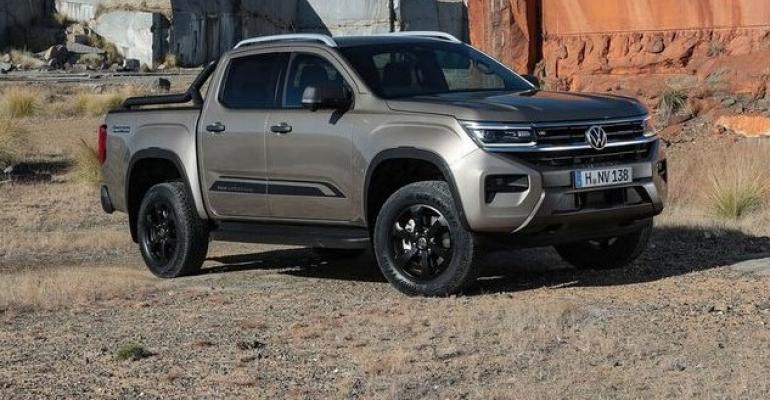Volkswagen reveals its second-generation Amarok pickup truck.
Twinned with the latest Ford Ranger, alongside which it was conceived, developed and engineered in a “global alliance” program that took place in Australia, Germany and the U.S., the Amarok is planned to go on sale in selected markets by the end of 2022.
Key developments for the new VW include bolder styling, a more luxurious interior with new digital functions and more than 30 driver-assistance systems as well as a broader range of engines, including a top-of-the-line 247-hp turbocharged 3.0L diesel V-6.
Initial sales of the Amarok will center around a 4-door double-cab version. VW also confirms a 2-door single-cab workhorse model will join the lineup next year as part of a concerted effort to see the Amarok challenge established rivals such as the Toyota Hi-Lux, Mitsubishi Triton and Ford Ranger – the latter sharing its ladder-frame chassis, mechanical package, electrical architecture and other key elements.
With sales of the first-generation Amarok launched in 2010 now totaling more than 830,000 worldwide, VW has high hopes for its successor, with key markets including Australia, New Zealand, Africa, the Middle East and Europe.
As hinted at in earlier design sketches issued by VW, the 2023-model-year Amarok takes on a distinctly more modern appearance with a higher front featuring angular headlamps (optional with Volkswagen’s IQ Light functionality and matrix properties) with new-look daytime running lights, a slim-line grille and a so-called X-design front bumper graphic.
“For the new generation we have significantly modified the Amarok’s design, It is now more expressive,” says Albert Kirzinger, head of design at Volkswagen Commercial Vehicles (VWCV) in Hanover, Germany.
As with the structural hard points underneath its steel body, various elements within the exterior are common with the Ranger, including the windshield, roof, side and rear windows, door handles and mirror housings. The remainder, including the design of the hood, fenders and outer door skins, is unique to the Amarok.
Along the sides, the second-generation pickup receives larger wheelhouses front and rear.
Volkswagen also has provided the Amarok with a more prominent styling bar. It serves to visually lengthen the cabin, giving the new model an added dash of style compared to its predecessor.
The cargo box offers an increased payload of up to 2,557 lbs. (1,160 kg). It can be secured with an electrically operated roll cover similar to that offered on the Ford Ranger Wildtrack and operated either from the cargo box itself, inside or remotely via the key fob.
The Amarok is 3.8 ins. (97 mm) longer than before at 210.6 ins. (5,349 mm) in double-cab form, while the width decreases 1.3 ins. (33 mm) to 75.2 ins. (1,910 mm). Depending on the wheel and tire combination, the height increases 0.4 in. (10 mm) to 74.3 ins. (1,887 mm).
The biggest change is the wheelbase, which has been extended 6.8 ins. (173 mm) to 128.7 ins. (3,269 mm).
With shorter overhangs, VW says the new-generation Amarok is better suited to off-road driving than its predecessor with front and rear approach angles of 29 and 21 degrees, respectively, as well as a ramp angle of 21 degrees.

Inside (pictured, above), the pickup shares elements of its dashboard fascia, infotainment display (standard at 10.0 ins. [25 cm], with upper-end models receiving a 12-in. [30-cm] unit) and various controls with the Ranger. However, VW has made a concerted effort to give the Amarok an appeal of its own with features such as a uniquely styled leather-bound multi-function steering wheel, digital instrument graphics, center console switches and gear lever as well as materials different from those used in the Ford.
The infotainment functions are controlled by the Ford-developed SYNC4 operating system but receive VW-specific graphics, while the old model’s manual handbrake is replaced by a new electric handbrake function.
The Amarok will be produced with three engines in seven different power outputs, some but not all shared with the Ranger.
They include a 2.0L diesel 4-cyl. developing 148 hp and 228 hp in single-turbocharged form as well as 201 hp and 207 hp in twin-turbocharged guise.
It is joined by a larger 3.0L diesel V-6 diesel with either 237 hp or 247 hp depending on the market it is sold – both with 443 lb.-ft. (601 Nm) of torque.
A turbocharged 2.3L gasoline engine with 298 hp also will figure from the start of sales later this year.
Overall, there are four different gearboxes, including 5- and 6-speed manuals as well as 6- and 10-speed automatics.
Buyers also will be able to choose between two different 4Motion all-wheel drive systems, depending on the engine: one offering part-time properties based on driving conditions and one with permanent properties and a 2-speed electromechanical transfer case.
Enhancing its off-road properties is a considerable increase in fording depth, from 20 ins. (500 mm) to 32 ins. (800 mm).
The Amarok features a double-wishbone front and beam axle with leaf-spring rear suspension, the same setup used by the Ford Ranger.
As with the first-generation model, the rear shock absorbers are mounted outboard of the chassis rails to free up space and provide what Lars Krause, VWCV board member responsible for marketing, describes as “more car-like” properties than competing pickups that use inboard-mounted dampers.
Production of the second-generation Amarok is scheduled to launch in September at Ford’s Silverton manufacturing plant in Pretoria, South Africa. The first-generation model will continue to be produced at the VW plant in Pacheco, Argentina, for various South American markets.






